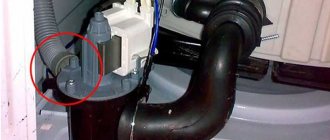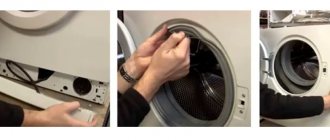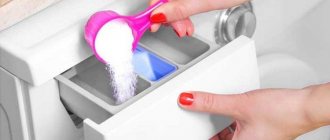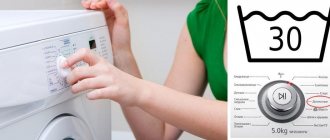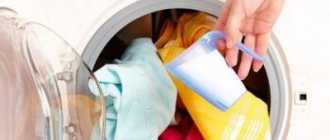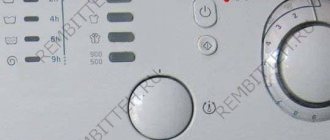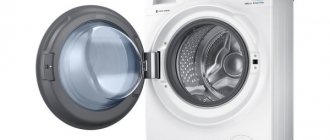How to clean the rubber band in an automatic washing machine from dirt. SMAs effectively replace manual labor and make the life of housewives easier. To ensure that the equipment does not fail, it requires proper care.
Periodic cleaning of various elements is a reliable prevention of breakdowns. The sealing cuff is no exception. In order not to one day find stains or smell mold, the rubber seal must be properly cleaned.
- Causes of unpleasant odors, scale formation, and mold
- Where to start cleaning the sealing rubber?
- Mold removal procedure
- Ways to eliminate odor and scale
- Treatment of the MCA cuff
- Cleaning compounds
- Preventive actions
- Catalog of washing machines with reviews
Causes of unpleasant odors, scale formation, and mold
When bacteria and fungus spread inside the equipment, a plaque is created and an unpleasant odor appears. Ideal conditions for the life of microorganisms are heat, dirt residues, high humidity and lime deposits.
If you always wash things at low temperatures, and also use the quick wash mode, disinfection does not occur, microorganisms do not die, but favorable conditions are created for their reproduction. To prevent this from happening, after each cycle you should thoroughly wipe the cuff and the inner surface of the drum.
Washing machine cuff with mold
Don't skimp on bleach. If processing of things occurs in its constant absence, then this also negatively affects the condition of the gum. It is a bad habit to store dirty things in the drum or keep the door closed all the time.
Expert opinion
I work in the household appliance repair industry. Extensive experience in restoring washing machines and dishwashers.
Ask a Question
Many rinses create plaque, which is a favorable environment for the life of various fungi and bacteria.
The main causes of plaque:
- operation at temperatures not exceeding 60 OC;
- excess rinses or gels;
- unsatisfactory powder quality;
- lack of regular care;
- high humidity;
- storing used laundry in a drum.
The reason for the formation of lime deposits is poor water quality, its hardness and excessive content of mineral salts.
Why does mold appear?
Before you start fighting the fungus, you need to understand the reasons for its appearance so that similar problems do not bother you in the future. The appearance of mold can be caused by various reasons, but most often the fungus appears if:
Various conditioners and softeners, as well as powder, can leave a slimy coating on the walls. After each start, you need to clean the washing machine and check whether there are any soap stains left on the drum or deposits on the seal.
Periodically, the drum and elastic band need to be cleaned of dirt and scale, and wiped dry after each wash.
- Rarely wash on a long cycle at high temperatures.
If you prefer a short wash at a low temperature, then you will have to fight the fungus more often and for longer. The fact is that at 40–60 °C mold spores do not feel discomfort - the unit does not undergo disinfection. The more often you wash your clothes on long cycles at maximum temperature, the better.
The longer the wash lasts, and the higher the water temperature, the better the machine is disinfected.
- Choose cheap laundry detergents.
Powders that contain few active substances do not clean the drum and other elements of the machine as well as more powerful bleaches do. It is better to opt for a stronger washing powder. Active bleaching components do not allow creating favorable conditions for mold growth inside the equipment.
The higher the quality of the powder/bleach, the more thoroughly the internal parts of the machine are cleaned, where mold can form.
In addition to improper care of the machine, the conditions in the bathroom can also cause mold. If the room is rarely ventilated, the temperature and humidity levels often rise, black fungus may appear, not only in the machine, but also on the tiles or on the ceiling.
Therefore, it is important that the bathroom is not damp - after water procedures, the room must be thoroughly ventilated.
To quickly ventilate the bathtub, I recommend installing fans, as in the photo
Where to start cleaning the sealing rubber?
First of all, you should identify places where dirt collects and fungus has spread. The equipment is disconnected from the electricity, the door is opened and the rubber is carefully inspected, carefully turning away the folds around the entire circumference.
Particular attention must be paid to the lower part. It is best to do this immediately after the end of the next cycle, before the moisture evaporates.
Cuff
The outer part of the elastic is wiped with a damp cloth, then the folds are turned away and the indentations are processed. To work you will need:
- viscose napkin,
- foam sponge,
- rubber gloves to protect hands,
- cleaning gels or powders.
Do not use abrasives or chemical solvents to avoid damaging the seal material.
What means can be used?
Let’s briefly summarize what products can be used to clean mold from a washing machine:
- chlorine-containing substances: Domestos, Belizna;
- alkaline compounds: soda, alkali;
- acidic substances (not too aggressive): vinegar, citric acid;
- copper sulfate;
- for cleaning the drain hose: sewer cleaning compounds (Tiret, Mole and others);
- auxiliary substances (do not kill mold, so they are used in conjunction with those listed above to clean surfaces): dishwashing detergents, washing powder, etc.
Mold removal procedure
The device is cleaned in several stages:
- wipe the surface with a damp cloth and remove plaque;
- turn away the edges and process the folds where dirt usually collects;
- put on gloves and soak a napkin in a chlorine-containing solution;
- clean the drum, as well as the inner and outer parts of the rubber;
- close the door and leave for 40 minutes;
- start the rinse mode and completely clean the device of chemicals.
Do you turn off the water tap after washing?
Oh yes! No.
Another effective way to save a car is to treat it with copper sulfate:
- A tablespoon of blue crystals is dissolved in one liter of water and the problem areas are carefully treated with the resulting liquid.
- The unit is left in this form for a day.
- To clean, turn on the quick wash mode at any temperature.
If there is too much mold, then the measures may not be effective enough. In this case, you will have to change the cuff. Please note that this is not easy to do on some washing machine models. The main reason is the non-separable case, or non-removable front panel.
Attaching the clamp to the cuff
Review of effective gum cleaning products
Popular products for removing odors and mold from rubber washing machines allow you to clean, simultaneously disinfect and refresh surfaces:
- Whiteness (bleach). Suitable for unworn cars, since chlorine can corrode old parts (hose, seal), cracked paint.
- Domestos. It is better to take the liquid form of the product.
- Silit Bang helps to quickly remove rust and scale from rubber.
- Bugs Anti-mold.
- Deo-anti-mold for automatic cars.
- Amway brand products.
- Pemolux.
The listed substances are used for the machine strictly according to the instructions, wearing protective gloves and a respirator. Household chemicals containing chlorine can clean washing rubber and cause burns to the mucous membranes or an allergic reaction.
Ways to eliminate odor and scale
The easiest way to get rid of them is using available home methods. The following solutions are suitable for this:
- citric acid,
- chlorine bleach,
- soda or vinegar.
The surface is wiped from moisture and treated with a cloth soaked in a solution of medium concentration. The darkened areas are carefully cleaned with soda, after which the unit is started with an empty drum at 60 OC.
Do you store laundry in the washing machine?
Oh yes! No.
Special store-bought formulations or citric acid will help get rid of scale. It is added to the container in an amount of 100 grams and a long-term mode is started, setting the temperature to at least 60 OC.
Another way is to add 60-70 ml of table vinegar to the rinse aid compartment, and then run the mode at elevated temperature. After 20 minutes, stop the device and wait about an hour, then continue operating the equipment.
Acidic products should not be used more often than once every 6 months, so as not to harm the rubber.
To quickly eliminate an unpleasant odor, wipe the cuff with a foam sponge moistened with any dishwashing gel. Fix the result with a single wash at 60 OC, adding a dishwasher tablet to the tray.
Checking the cuff
Prevention
To prevent the appearance and spread of mold, you just need to remember the basic rules for caring for your assistant:
- Regularly ventilate the room where the washing machine is installed. If necessary, install forced ventilation.
- You can defeat mold in the washing machine drum and in the cuff if you leave the door open and pull out the dispenser, providing air access to the mechanism.
- To get rid of the remaining water manually, use a regular sponge to collect the moisture in the rubber of the washing machine. You can drain the water from the drum through a small filter hose.
- Use high-quality washing powders. Do not exceed the dosage of the product - the excess will settle on the internal mechanisms, forming a plaque. This is especially true for gel products, since they are especially difficult to wash out of the body.
- Once a month, run the wash at 80–90 degrees with the addition of chlorine bleach.
- Remove items from the drum immediately after washing. Do not store dirty items in the drum, especially if they are wet.
- Wipe rubber seals dry after each wash.
- Once every six months, carry out general treatment with vinegar or citric acid: 1 liter of vinegar 9% or 200 g. citric acid, temperature 50–60° C. When working with household chemicals, carefully read the instructions.
- It is necessary to clean the filter and hoses regularly, because this is where organic residues accumulate - a suitable place for fungus to grow.
With proper care, a washing machine can serve its owners for more than 10 years. Buying a new device is an expensive pleasure. Careful care of household appliances will ensure comfort in your home and save your family budget.
Treatment of the MCA cuff
If the contamination is too strong, it is better to remove the seal and treat it separately. This is done as follows:
- use a narrow screwdriver to pry up the wire clamp that holds the rubber;
- pass the tool in a circle and remove it;
- carefully remove the seal, avoiding contact with the electronic door lock;
- thoroughly wash the part in water, adding a small amount of bleach to it, for this use a container of sufficient volume;
- rinse under the tap and wipe with a dry cloth.
If defects are discovered on the cuff during care, it will have to be replaced.
Is a dishwasher profitable?
Oh yes! No
Methods for cleaning dirt
Since rubber is a soft material, it is better to choose more gentle products in the form of gels and liquids. Powder and abrasive compounds thin the material and cause rapid wear of the rubber, and mechanical methods can damage it.
The easiest and safest option is to wipe the cuff with a sponge soaked in dishwashing detergent. This will not only remove dirt, but also give a fresh, pleasant aroma.
If the stains are persistent, this composition will do. A shaving of laundry soap, a drop of dishwashing detergent and a drop of bleach are diluted with a small amount of water and foamed. All this is applied to the cuff and left for several hours, after which the idle wash mode and double rinse are turned on. Finally, the rubber is wiped with a clean cloth and dried.
There is a special liquid machine cleaner designed for the highest quality cleaning. A special dishwasher cleaner will have the same effect.
Cleaning compounds
There are several groups of complex products that effectively solve the problem of cleaning and preventing the formation of odor or plaque. When choosing, it is important to look at the labeling. These may be the following options:
- special pressed tablets for dishwashers;
- cleaner for washing machines;
- means for removing limescale.
Removed front panel of the washing machine
Among store-bought products that prevent the formation of deposits, “Antinakipin” is also suitable. The recommendations on the packaging should be strictly followed.
The fungus is removed using traditional methods using copper sulfate, soda ash or baking soda. The development of microorganisms is prevented by chlorine-based compounds:
- "Domestos";
- "White";
- Bagi;
- "Sepotosan-T".
The Dutch HG, the Swedish Mogel-Fri and the Well Done Mold cleaner spray have proven themselves well. Comet or “Toilet Duck” is also suitable, the main thing is not to use abrasives and solvents.
Detergents and cleaning products suitable for disinfection
If there is not a lot of black mold accumulated, then you can get rid of it with the help of gentle substances that will not only cope with the problem, but also will not cause any harm to the washing machine.
Such means include:
- Popular detergents such as "Finish" and "Fairy";
- Special products for combating fungi and mold for household appliances;
- Dishwasher cleaners;
- Copper sulfate solution;
Each product on the list can completely disinfect the gum, saving it from new problems for a long time. The products will also help if the rubber band is blackened by mold.
The principle of their operation is similar to each other, so you shouldn’t delay choosing a cleaner for too long. How to clean the washing machine with them is described in detail on the packaging. There are also a number of effective products that you can make yourself:
Preventive actions
To prevent deposits or odor from reappearing, you must adhere to the following recommendations:
- After operating the unit, remove moisture by wiping the drum and seal with a clean cloth;
- do not often use low-temperature modes;
- keep the door ajar between jobs;
- provide good forced ventilation in the room;
- do not leave washed clothes in the tank for a long time;
- do not use gels that cover the internal surfaces and create an environment favorable for the development of microorganisms;
- Once every 3-4 weeks, run an idle high-temperature cycle for the maximum time using high-quality powder and bleach.
Careful care of your washing machine will not only help prevent breakdowns and avoid costly repairs, but also maintain your health. But first of all, you need to clean the car from dirt inside under the rubber and outside.
Video
How to clean a car under the rubber
It is no secret that the rubber band can be removed completely and the surface underneath can be thoroughly washed. The scheme is simple:
- It is necessary to use a screwdriver to pick up the clamp on which the rubber cuff is attached
- You need to remove the clamp, carefully use a screwdriver in a circle
- Next, you can remove the rubber cuff
- Wash off any visible dirt from the gum with water.
- Soak the seal in a chlorine-containing substance
- Dry the part and put it back.
If you have difficulty removing the rubber band, but need to clean it, you can call an equipment maintenance specialist.
Complete washing machine cleaning procedure
You can completely clean your washing machine using citric acid.
- You will need several packs of citric acid (which depends on the loading volume of the machine)
- Pour the acid into the washing powder compartment.
- Run the machine at maximum speed for a long wash.
The acid will clean the machine of scale and also get rid of foreign odors.
If all else fails
Unfortunately, in reality there are such advanced cases that none of the presented methods helps eliminate mold on the elastic of the washing machine. In such a situation, there is only one effective method - replacing the seal. With this question, it is better to contact a special service department, where qualified craftsmen will get down to business.
If you decide to replace the rubber band on your washing machine yourself and do something incorrectly, this may cause a leak, which will negatively affect the further operation of the equipment.
Mold is an unpleasant sight no matter where it appears. However, few people know that such a fungus can be very dangerous to human health. And if it forms on a washing machine, then this only aggravates the situation. Fortunately, it can be eliminated with the help of ingredients that we often use in everyday life. And if you then adhere to preventive measures, then you can forget about mold forever.
Lemon acid
This is another budget-friendly product that will help deal with mold on the rubber band of your washing machine. I think every housewife has citric acid in her kitchen. You will also need any cleaning agent. I use Domestos. It is inexpensive and effective.
First you need to prepare your work surface. Wipe the elastic band thoroughly with a simple damp cloth. You can use a simple dishwashing sponge soaked in a mild soap solution. Try to remove all debris and dirt accumulated in the seal.
Next, apply Domestos or another household appliance cleaner to the rubber band. Take a damp cloth, dip it in the powder, and then go over the seal. Try to wipe all hard-to-reach places, otherwise the mold will return again.
Close the washing machine door tightly and leave for at least 2 hours. After this time, turn on the “Rinse” mode without removing the powder from the gum. Before turning on the washing machine, pour half a glass of citric acid into it. The temperature should be at its maximum. It is recommended to do this manipulation twice.
